Battery Basics – How To Wire RV Batteries
Learn how to wire RV batteries the right way, as well as check to make sure the dealer got it right too. In this article, we’ll go over how to wire RV batteries and why. We’ll also show you what to look out for, parallel vs series connections and 6 & 12-volt batteries. Let’s dig in!
Battery Basics – A Series to Learn About Batteries
Battery Basics – Types of RV Batteries
Battery Basics – How to Care for RV Batteries
Battery Basics – True Deep Cycle vs Dual Purpose
Battery Basics – How to Wire RV Batteries
Battery Basics – RV Battery Sizing


Sign up for the best off-grid solar info!
Terminology We’ll Use
- 12-volt & 6-volt – RV batteries come in 2 main voltages, 12-volt and 6-volt. RV electrical systems are generally 12-volt in the USA. A single 12-volt, or 2, 6-volt battereis are needed for an RV.
- Battery Bank – This just means more than one battery. It could be 2, 3, 4, 12, etc. It can also reference 12-volt or 6-volt batteries.
- Amp-hours – This is a common rating system for deep cycle batteries (80 Amp-hour, 100 Amp-hour).
- Parallel, Parallel Batteries, Parallel Connection – Wiring two or more batteries positive to positive and negative to negative so the voltage stays the same, but the Amp-Hours increase.
- Series, Series Batteries, Series Connection – Wiring two or more batteries positive to negative to increase the voltage. Very common to wire 2, 6-volt batteries in series to create 12-volts (amp-hours stay the same)
- AWG or Gauge – Wires are sized by gauge, common RV battery wire size is 6 AWG or 4 AWG (the smaller the gauge the larger the wire). There are also very large wires that start at 1/0 AWG or 1/0 Gauge. AWG stands for American Wire Gauge.
- VDC, Volts Direct Current – Direct current is a term to differentiate between types of voltages. Batteries are a direct current while powerlines and household power are Alternating Current or AC.
What is a battery bank?
A battery bank is simply more than one battery connected together to make a larger battery system. By connecting more than one battery you can get more power capacity (increased amp-hours), or higher voltages. A battery bank consists of connecting batteries in series, parallel, or a combination of series and parallel together.
Why Add More Batteries to an RV?
More batteries mean more power. More power means you get to stay out longer without the need to hook up to shore power or run a generator.
In order to run the devices in your RV, you need adequate electrical power. A single battery can only run so long before it’s dead or needs a recharge. In order to reduce the need for running a generator or having more solar than what’s necessary, a larger battery bank can help.
Additionally, if you use lead-acid type batteries you can increase the lifespan of your battery bank by making sure it’s sized correctly. Lead-acid batteries, even deep cycle batteries, will last longer if you don’t let them get too low. A good rule of thumb is to never let them get below 12-volts, or 12.00VDC. By the way, a full battery is around 12.7 to 12.8VDC.
If you’re out camping for 1 day and your batteries get down to 12.0VDC, you should recharge them. However, if you have more battery power, you could go 2, 3, or more days until you reach 12.0VDC.
What is the difference between parallel and series battery connections?
There are basically two different ways to combine multiple batteries together for use in an RV. It’s common to add more batteries to your RV to increase the battery capacity (or the amount of power you have) so you can run more devices or stay out and camp longer.
Parallel Connection – Keeps the voltage the same but adds battery capacity (amp-hours) together. So if you have 2, 12-volt batteries with 80 amp-hours of capacity each you’ll still have a 12-volt battery bank but 160 amp-hours of battery capacity.
Series connection – Increases the voltage, generally double the voltage when using the same voltage batteries. 2, 6-volt batteries wired in series create a 12-volt battery bank. The capacity of the batteries remains the same. So, 2, 6-volt batteries at 75 amp-hours each make a 12-volt battery bank at 75 amp-hours total capacity.
2, 12-Volts in Parallel
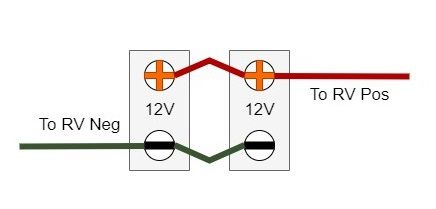

A parallel battery connection is a way to connect 2 or more batteries and keep the voltage the same but increase the power capacity. This is commonly done in RVs when using 12-volt batteries. By connecting one or more 12-volt batteries the voltage of the battery bank remains at 12-volts, but the power of each battery is added together.
2, 6-Volts in Series


A series connection is a way to increase the battery voltage. If using 2, 6-volt batteries the batteries combined equals 12-volts. Great for use in RVs. Similarly, using 6, 2-volt batteries in series can create a 12-volt battery bank. But, the capacity of the batteries remains the same when combined in a series connection.
Should I Use 12-Volt or 6-Volt Batteries for my RV?
It doesn’t matter if you use a 12-volt or 6-volt battery for your RV. But what does matter is that you use a TRUE DEEP CYCLE battery. Read more about deep cycle batteries, and how they differ from other battery types.
There are several different variations of 12-volt batteries that are used in the automotive industry, but basically 1 kind of 6-volt battery. Since batteries aren’t well understood it’s easy to choose the wrong 12-volt for the job. Most people who swear by 6-volts have made the mistake of using a 12-volt battery that wasn’t designed for what they needed. For instance, using a car starting battery for your RV or boat trolling motor isn’t the same as using a battery designed to handle that usage.
Since there aren’t many variations of 6-volts, and 6-volts are heavy and have a very specific usage, many people have had a better experience with them. This has created a confirmation bias against 12-volts and for 6-volts for your RV.
A deep cycle battery is built differently compared to a car starting battery or trolling motor/dual-purpose battery. A deep cycle battery can handle deeper discharges and recharges better and they are better suited for your RV. 6-volts are commonly used in golf carts, RVs, and industrial machines like forklifts.
We suggest looking for 12 or 6-volt batteries that are designed to be used with renewable energy. These types of batteries will work well for an off-grid system or for your RV – even if you don’t use renewable energy. Do use caution when looking for an RV-specific battery. Many companies market these batteries for RV or marine – not the same as a true deep cycle battery.
The Wrong Way to Wire RV Batteries
There are several different ways a battery bank can be wired. If you don’t understand the internal workings of a battery it can get confusing quick. We’ll go into a few common examples of how NOT to wire your battery bank, and then a few ways to wire a battery bank that we prefer. But first, we need to mention battery balancing.




What is Battery Balancing?
This can is a deep and technical subject, we’re only going to hit on this from an aspect of balancing a multiple battery system for your RV, and try to keep it as simple as possible.
Battery balancing for RV batteries is a concept or technique to help “balance” the usable capacity of every battery in the battery bank for healthier and longer-lasting batteries.
The way a battery is wired can either help or prevent each battery in a battery bank from being used too much or charged too little. The electricity in a battery flows much like water or air, it goes to the most direct path or the path with the least amount of resistance. The least amount of resistance for a battery is through the battery.
In the diagram to the right, the RV is wired directly to battery 1. Since the least resistance is through battery 1 it will see the most amount of depletion. It will also see the most amount of charging.
And once that battery gets near full it can signal to the charger that it’s near full and the current can be reduced – regardless of the other batteries.
Battery 2 and 3 will do their best to help supply power to the load but are restricted due to wiring. They will also take power from the battery before it when it can.


It’s not uncommon to have issues with your batteries when they are wired wrong. Even a 2, 12-volt battery system in parallel can have issues with supplying power and longevity. For the best battery life and usable power, the wire connections from and to your RV and charging source should be in proper locations so ALL the batteries get the right amount of charge.
Issues you may encounter:
- Battery bank doesn’t have enough power (run-time).
- The battery furthest from the RV connection has a shorter lifespan.
- Your entire battery bank has a shorter lifespan.
- Battery bank discharging and charging faster than it should.


The Best Way to Wire an RV Battery Bank – And Most Expensive
If you had the choice and the amount of money you spent on wires and wire connections wasn’t an issue this is the way you should wire your batteries.
This works well for 12-volt batteries and has to be modified for 6-volt batteries. But
The key here is that ALL the wires that connect to the battery and the single terminal (can be called bus bar or terminal point too) are all the same size. The power from the batteries and to the batteries all has the same resistance so each battery gets the same treatment.


The only downside is that thick wires for batteries, 4-AWG or larger, can get expensive, quick. And you’ll want to make sure that each connection is well prepared, a loose wire can be very problematic. When you’re wiring up 4, 6, or more batteries it adds up.
Wiring a larger battery bank this way will allow the electricity to flow to where it needs to go with very little resistance from the rest of the system. Wires and the length of the wires can create different electrical resistance when they’re different.
Other Great Ways to Wire RV Batteries
What we showed you before was likely the best way to wire multiple RV batteries for the best balancing. But there are other great ways to wire your batteries and the difference between great and best isn’t all that much with an RV system. An RV battery system doesn’t have very high tolerances and we can sacrifice a bit of perfection for very similar performance.
Connect 2, 12-Volt Batteries to Your RV
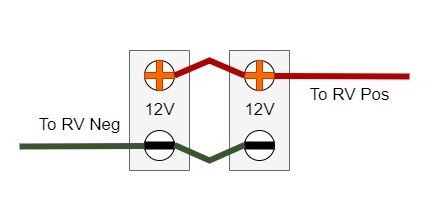

Connecting 2, 12-volts is pretty straightforward. Just don’t connect them as we showed you not to above.
Both batteries get the positive and negative terminals wired together.
Then you connect the positive of one battery to the RV and the negative of the other battery to the RV.
Connect 3, 12-Volt Batteries to Your RV
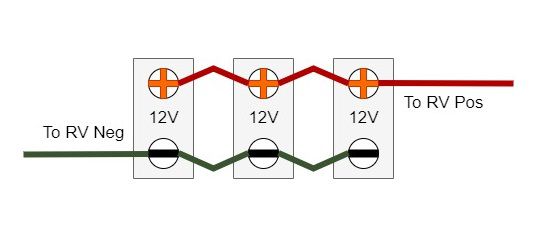

This isn’t as good as the BEST way to wire your battery bank as we showed you above, but it will work very well. The power still has to travel through all the batteries fairly equally.
Connect the positives of battery 1, to 2, and 2 to 3. Same with the negative.
But make sure to connect positive and negative out to the RV on the outermost batteries in the system.
Connect 4, 12-Volt Batteries to Your RV
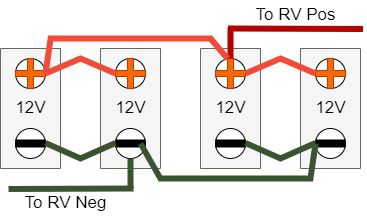

This one gets a bit tricky. In order to get a great charge and power usage to and from every battery, you need to make sure to isolate the batteries into 2’s and connect them together.
Notice how battery 1 and 2 are parallel, same with battery 3 and 4.
Then battery 1 and 3 have a positive parallel connection, and 2 and 4 have a negative parallel connection.
Working with ODD Number of 12-Volt Batteries
If you’re working with 5, 7, 9, or more, an odd number of batteries, you might have to get a little creative and be willing to leave an odd battery out of an optimal charge. The alternative is to wire all your batteries up the way we diagramed out above as the BEST way to wire up batteries. This can get expensive fast, but if your battery bank is that large you’ll want to protect your investment.
Connecting 2, 6-Volt Batteries to Your RV
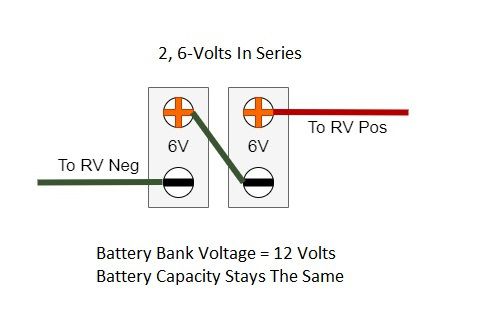

2, 6-volt batteries are needed to equal 12-volts for your 12-volt RV system.
Connect the positive of 1 battery to the negative of the other.
Then connect the RV to the open terminals on opposing batteries.
This increases the voltage to 12-volts but keeps the amperage the same. It would be important to use the same size 6-volt battery – matching make and model are a good practice. The amperage of the system is that of 1 of your batteries.
Connecting 4, 6-Volt Batteries to Your RV
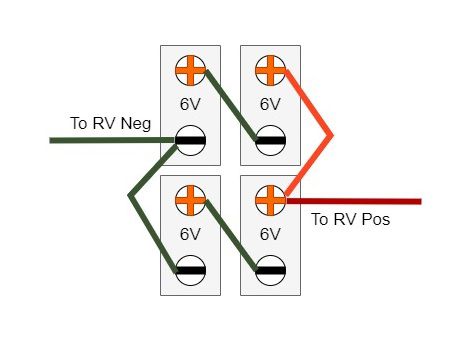

These batteries are wired in series and parallel. This increases the voltage to 12-volts and increases capacity.
When working with 6-volt batteries for a 12-volt RV system there are no options for an odd number of batteries.
You need to use 2-6-volts, 4, 6-volts, 6, 6-volts, and so on.
2, 6-volt batteries are wired in series for 12-volts. Positive to negative connection. Then another 2 are connected the same.
Those 2 battery banks get wired in parallel, positive to positive and negative to negative, to keep the system at 12-volts but increase the capacity of the system.
Wiring Larger 6-Volt Battery Banks for RVs
If you need a larger system using 6-volts you can treat 2, 6-volt batteries as a 12-volt battery and wire them the same way we recommend above for the larger 12-volt battery banks.
What Size Wire Should You Use for RV Batteries
For most RVs 4AWG wire is a good choice. 6AWG can also be a good choice (6AWG is smaller than 4AWG). But if you’re doing a custom project or wiring in devices, like a large inverter, then your wire size should be calculated. The number of amps and the length of the wires is important.


The correct wire gauge for your battery cable size is determined by current and distance. You will need to know how many amps your system will pull and the length or distance of the wires.
After you have these two pieces of the puzzle you can consult a DC wire chart for the recommended wire gauge for your project.
Where Should I Wire Solar into an RV Battery Bank
In most situations, you should wire the solar wires at the same spot that you wire the RV wires. However, if the posts become too cluttered or space is a big constraint you can wire the exact opposite of the RV wires.
Another and better alternative in tight spaces is to use a terminal block. A terminal block allows multiple connections on a wider area and is sometimes fused.
Check Your Wiring – Even From the Dealer
Whew, that was a load of info. I hoped there is a ton of good information you can use. It’s worth checking how your RV is wired, even if you get it from a dealership. I’ve worked with several people who had battery issues due to poor wiring from a dealer or service center.
Still not Sure, Get Help
We help people wade through the complexities of solar battery charging. RV batteries are a big topic. We have years of experience and knowledge when it comes to them. We hope this article helped. We’ll be creating more when we get a chance. If you want to be notified when we have more info, sign up below.
And for this reason, if you’re still confused you can reach out to us. We can do an energy audit for you and calculate what size battery, type, and voltage might work for you. We can also size your solar system. We’ll need to hop on a call and get some info and ask some questions so we can get you rolling with some good recommendations.
For this consultation, we do have a fee of $49.95 per consult. Just reach out to us – info@backcountrysolar.com if interested.



